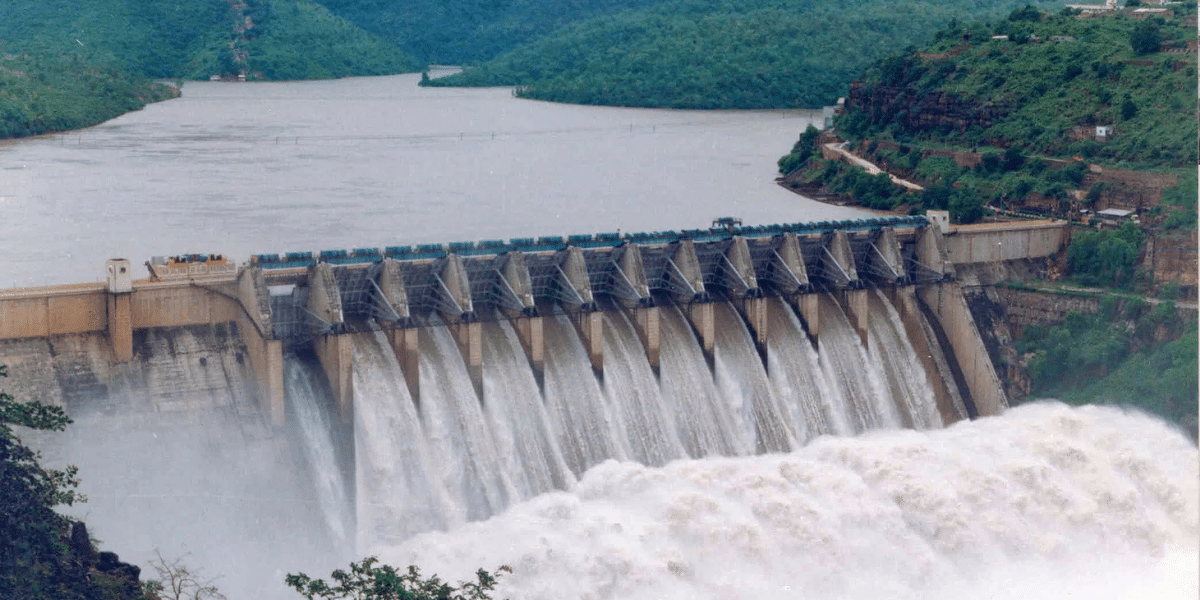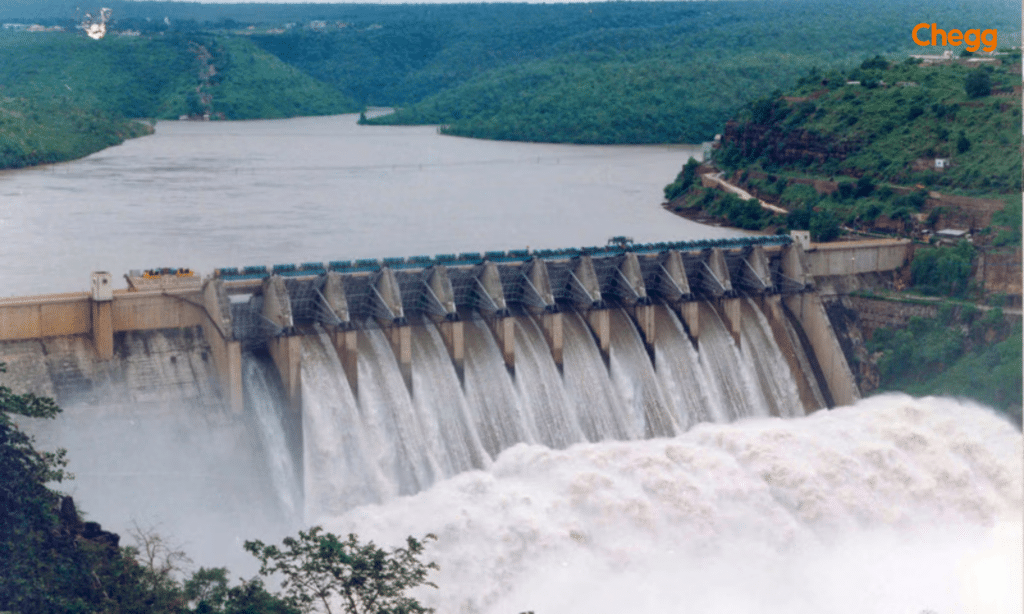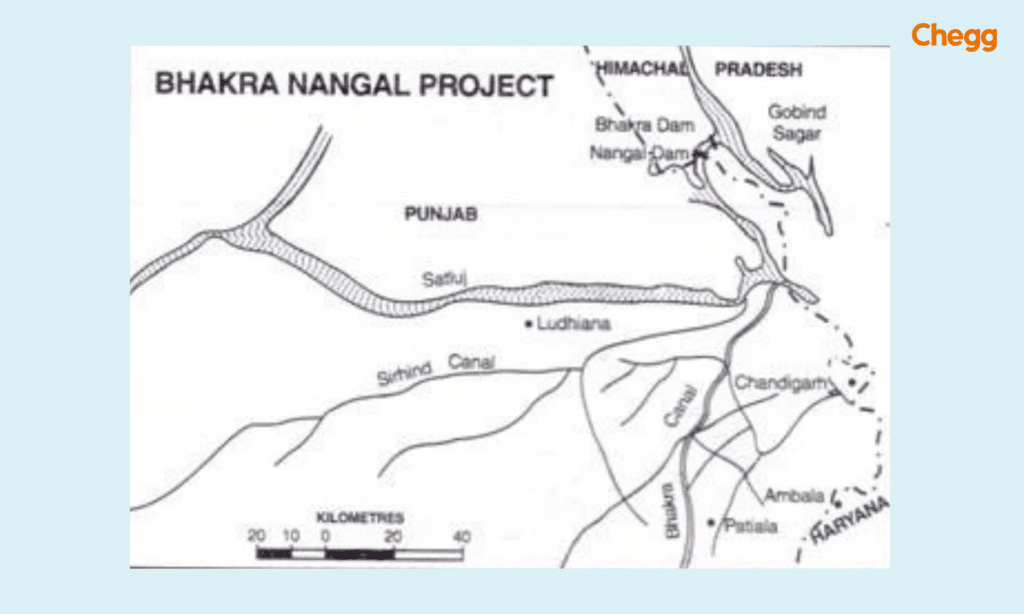
Quick Summary
Table of Contents
The Bhakra Nangal Dam is a renowned engineering marvel on the Sutlej River in northern India, comprising two dams Bhakra Dam and Nangal Dam. The Bhakra Dam, located near Bhakra village in the Bilaspur district of Himachal Pradesh, is the tallest straight concrete gravity dam in the world, standing 226 meters (740 ft) high and 518 meters (1,700 ft) long. Downstream in Punjab lies the Nangal Dam, a smaller earthen dam measuring 11 meters (36 ft) high and 13,000 meters (43,000 ft) long. Together, these structures form the Bhakra-Nangal Dam complex. Apart from being a vital hydroelectric project, the dam has created the Gobind Sagar Reservoir one of India’s largest with a storage capacity of 9,867.86 MCM .
Its two powerhouses on the left and right banks generate around 5,400 million units (MU) of electricity annually, making it a cornerstone of irrigation, power supply, and water management in northern India.After India gained independence, they had a big problem figuring out how to manage their water resources. The Bhakra Nangal Dam was a great solution because it provided water for many uses and helped improve India’s infrastructure. It was a real turning point for the country.
The Bhakra Nangal Dam complex is built on the Sutlej River. The Sutlej River itself is part of the Indus River system. The Indus originates in Tibet and eventually flows into the Arabian Sea in Pakistan. Though the Bhakra Nangal Dam is on the Sutlej, its waters don’t directly contribute to the Indus. They are diverted for irrigation and power generation before reaching the confluence with the Indus. This is due to agreements like the Indus Waters Treaty between India and Pakistan.
The Bhakra Nangal Dam’s location on thе Sutlеj is no coincidеncе. Thе rivеr’s flow and thе dam’s еnginееring work in harmony to storе watеr during timеs of plеnty and rеlеasе it during dry spеlls. This intricatе dancе еnsurеs a stеady supply of watеr for irrigation, powеr gеnеration, and othеr еssеntial nееds, proving thе dam’s vital role in India’s watеr managеmеnt stratеgy.

| Specifications of the Bhakra Nangal Dam | |
| Height | 741 ft (226 m) |
| Length | 1,700 ft (520 m) |
| Width (crest) | 30 ft (9.1 m) |
| Width (base) | 625 ft (191 m) |
| Total capacity | 7.551 million megalitres (266.70 Tmc ft) |
The reservoir of this dam is called the ‘Gobind Sagar.’ Gobind Sagar can store around 9.43 billion cubic meters of water. This reservoir by Bhakra Dam is 90 km long and spreads over 168.35 sq km. Moreover, this reservoir is also the third-largest in the country regarding water storage. The largest is the Indira Sagar Dam in Madhya Pradesh, followed by Nagarjunasagar Dam, the second largest.

The Bhakra Dam stands as a vital asset to India, offering a multitude of benefits:
The Bhakra Nangal Dam is strategically located on the Sutlej River, spanning Himachal Pradesh and Punjab near the village of Bhakra in Bilaspur. It forms the vast Gobind Sagar reservoir and serves as a crucial hub for irrigation, hydroelectric power generation, and flood control. Positioned in the Himalayan foothills, the dam efficiently harnesses river flow to support regional development while attracting tourists with its engineering marvel and scenic beauty.

The Bhakra Nangal Project, situated along the Sutlej River, serves as a reservoir for river and rainwater. Adjacent states benefit from this dam by utilizing its resources for electricity and irrigation purposes. Primarily aimed at providing irrigation water, the project caters to the needs of Punjab, Haryana, Himachal Pradesh, Chandigarh, Delhi, and Rajasthan. Additionally, these states rely on the power generated by the dam’s stations. The project features the Gobind Sagar reservoir on the Punjab-Himachal Pradesh border. Its left and right powerhouses boast capacities of approximately 550 MW and 750 MW, respectively, for hydroelectric power generation.
Before the Bhakra Nangal Dam was built, much of Punjab and surrounding areas were too dry for practical farming. The dam’s reservoir brought essential water to these lands, enabling year-round irrigation that boosted agricultural productivity. Farmers could grow multiple crops annually with reliable water access, transforming the region into India’s farm heartland and sparking the Green Revolution. The dam’s impact continues to sustain generations of farmers, supporting their livelihoods and strengthening India’s food security.
These advancements were primarily supported by improved irrigation and better water resource management in the regions.
The Bhakra Nangal Dam harnesses the Sutlej River to generate substantial, renewable energy. With its high capacity, the dam’s power plant provides clean electricity that illuminates homes and fuels industries, playing a key role in India’s economic development. As a reliable power source, it lessens dependence on fossil fuels and contributes to environmental sustainability. This hydroelectric facility exemplifies India’s commitment to sustainable energy, enhancing energy security while meeting growing demands in an eco-friendly way.
The Bhakra Nangal Dam is a critical flood control system for northern India, especially during the monsoon season. Regulating the Sutlej River’s flow prevents downstream flooding by holding back excess rainwater and releasing it controlled. This function offers security and stability for nearby communities, protecting their homes and livelihoods from potential flood damage. Bhakra Nangal is a reliable safeguard, continually proving its effectiveness in minimizing flood impact and ensuring community safety.
The Bhakra Beas Management Board (BBMB) traces its roots to the Indus Water Treaty of 1960 between India and Pakistan, which allocated the Ravi, Beas, and Sutlej rivers to India for exclusive use. A comprehensive master plan was devised to maximize these rivers’ potential for irrigation, power generation, and flood control, with the Bhakra and Beas projects at its core, established through joint efforts of Punjab and Rajasthan.
After Punjab was reorganized in 1966 and Haryana was created, the Bhakra Management Board was constituted under the Punjab Reorganization Act. Over time, it transformed into the Bhakra Beas Management Board, taking over management responsibilities for Bhakra Nangal and Beas Project Works. Today, BBMB regulates water and power supply across Punjab, Haryana, Rajasthan, Himachal Pradesh, Delhi, and Chandigarh.
BBMB’s management structure comprises a chairperson, two whole-time members from Punjab and Haryana, and nominated representatives from Rajasthan and Himachal Pradesh. This collaborative governance ensures effective coordination among partner states. With around 12,000 employees, including 696 Group A officers from partner states, BBMB plays a pivotal role in regional water resource management and power distribution, contributing significantly to the region’s socio-economic development.

Here are some interesting facts about the Bhakra Nangal Dam, one of India’s most essential and iconic infrastructure projects:
1. Location and Design
2. Construction and Completion
3. Dimensions
4. Purpose and Importance
5. Hydroelectric Power Generation
6. Irrigation Benefits
7. Environmental Impact
8. Historical and Cultural Significance
9. Strategic Importance
10. Tourism and Accessibility
11. Challenges and Upgrades
12. Unique Engineering
13. Nangal Dam
14. Legacy
The Bhakra Nangal Project is situated on the Sutlej River and is designed to store the river’s flow and rainwater. The neighboring states utilize the power from the dam and receive irrigation water to support their rural development. The Bhakra Nangal project is the object of providing irrigation for states, more specifically Punjab, Haryana, Himachal Pradesh, Chandigarh, Delhi, and Rajasthan. These states also obtain the electricity they require from the powerhouses of this dam project, and thus, the Bhakra Nangal project is also used to provide a power supply to these states.
The Bhakra Nangal Project, with the Gobind Sagar reservoir, is located on the borders of Punjab and Himachal Pradesh. The left powerhouse has a total installed capacity of about 550 MW, and the right powerhouse is rated at a total installed capacity of 750 MW of hydroelectric generation.
The Bhakra Nangal Dam is not only an engineering marvel but also a popular tourist attraction in Himachal Pradesh. Surrounded by scenic hills and the vast Gobind Sagar Lake, the dam attract thousands of visitors every year.
The best time to visit Bhakra Nangal Dam is from September to March, when the climate is pleasant and the lake looks stunning. Monsoon months (July–August) offer dramatic water views, but heavy rainfall may restrict access.
Visitors are drawn to the dam for its blend of history, natural beauty, and adventure. Whether it’s experiencing water sports at Gobind Sagar Lake, exploring spiritual sites nearby, or simply relaxing in the calm surroundings, Bhakra Nangal Dam tourism offers something for every traveler.
The Bhakra Nangal Dam is a remarkable feat of engineering and the second tallest dam in Asia, strategically located between Himachal Pradesh and Punjab. It not only ensures reliable irrigation that supports agriculture but also strengthens power generation across northern India. With a daily output of 31,691 cusecs of electricity and a significant boost in Punjab’s energy supply, the dam plays a crucial role in regional energy security, agricultural growth, and overall economic development.
Read More:-

The Bhakra Nangal Dam is famous for being one of India’s largest multipurpose river valley projects and the second tallest dam in Asia. Built on the Sutlej River, it is renowned for its massive Gobind Sagar Reservoir, record hydroelectric power generation, reliable irrigation support, and its role in transforming agriculture and energy security in northern India.
No, the Bhakra Nangal Dam is not the largest dam in the world. It is, however, one of India’s largest multipurpose river valley projects and the second tallest dam in Asia. Built across the Sutlej River, the Bhakra Dam is the tallest straight concrete gravity dam in the world, standing 226 meters high. While it is globally significant for its height, capacity, and power generation, the title of the world’s largest dam belongs to the Three Gorges Dam in China.
The Bhakra dam is the second-highest in India, behind the Tehri dam, at about 226 meters high and 518 meters long. It is also the world’s tallest straight gravity dam. The Bhakra dam was built on the Satluj River and is close to Nangal City on the Himachal Pradesh and Punjab border.
Located in Bhakra Village in the Bilaspur district of Himachal Pradesh, northern India, Bhakra Nangal Dam is a concrete gravity dam on the Satluj River. The dam creates the Gobind Sagar reservoir.
The Bhakra Nangal Dam had a total capacity of 7.551 million megalitres, or 266.70 thousand cubic feet (Tmc ft). The reservoir, Gobind Sagar, has a gross storage capacity of 9,621 million cubic meters (MCM) and a practical storage capacity of 7,192 MCM. This is enough water to flood Chandigarh, parts of Haryana, Punjab, and Delhi.
The Bhakra-Nangal dam’s primary purpose is irrigation and storing rainwater. The dam provides irrigation water to Haryana, Rajasthan, Gujarat, and Himachal Pradesh. The dam is also famous for tourism and generating electricity.
Jawaharlal Nehru, India’s first Prime Minister, is widely recognized as the father of Bhakra Nangal Dam. His visionary leadership and commitment to modernizing India’s infrastructure paved the way for enhanced power generation, irrigation, and flood control.
The highest dam in Asia is the Jinping-I Dam in Liangshan, Sichuan, China. It is an arch dam on the Yalong River, standing 305 meters (1,001 ft) tall, making it the tallest dam in the world.

Authored by, Muskan Gupta
Content Curator
Muskan believes learning should feel like an adventure, not a chore. With years of experience in content creation and strategy, she specializes in educational topics, online earning opportunities, and general knowledge. She enjoys sharing her insights through blogs and articles that inform and inspire her readers. When she’s not writing, you’ll likely find her hopping between bookstores and bakeries, always in search of her next favorite read or treat.
Editor's Recommendations
Chegg India does not ask for money to offer any opportunity with the company. We request you to be vigilant before sharing your personal and financial information with any third party. Beware of fraudulent activities claiming affiliation with our company and promising monetary rewards or benefits. Chegg India shall not be responsible for any losses resulting from such activities.
Chegg India does not ask for money to offer any opportunity with the company. We request you to be vigilant before sharing your personal and financial information with any third party. Beware of fraudulent activities claiming affiliation with our company and promising monetary rewards or benefits. Chegg India shall not be responsible for any losses resulting from such activities.